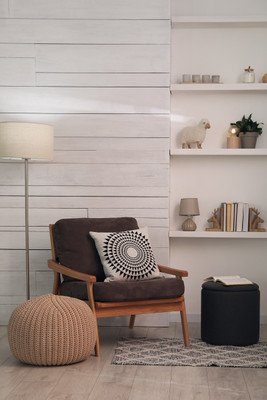Exploring the Magic of Textures in Interior Design
Posted by CF Style Team on on May 24th 2023
In the world of interior design, textures play a vital role in creating visually captivating and inviting spaces. From sleek and smooth surfaces to cozy and tactile elements, textures add depth, character, and personality to any room. In this article, we'll delve into the art of using textures in interior design, exploring how they can transform your space and awaken your senses. So, let's embark on a journey through the fascinating world of textures and discover how to create a harmonious balance that enchants both the eye and the touch.
The Power of Textures: The Key to Sensory Stimulation
When it comes to interior design, textures engage our senses in unique ways. Imagine running your fingers across a plush velvet cushion or stepping onto a cool, smooth marble floor. The touch of different textures not only adds a tactile dimension to a room but also creates a multisensory experience. By incorporating various textures, you can evoke a range of emotions and set the mood in your space.
Layering Textures: Creating Depth and Visual Interest
One of the fundamental principles of using textures in interior design is layering. Just as a painter applies brushstrokes to create depth and dimension in a masterpiece, interior designers layer textures to achieve a visually captivating space. Combining different textures such as rough brick walls, soft faux fur throws, and glossy ceramic vases adds depth, visual interest, and a sense of richness to a room.
Natural Textures: Bringing the Outdoors In
Natural textures have an undeniable charm that effortlessly brings warmth and a touch of nature into any interior space. Materials such as wood, stone, and rattan add a sense of authenticity and organic beauty. Incorporating natural textures can create a serene and soothing environment, invoking a connection with the outdoors and promoting a sense of well-being.
Textured Walls: Making a Statement
One of the most impactful ways to introduce textures into your interior design is through textured walls. Whether it's exposed brick, intricately patterned wallpaper, or textured paint finishes, these statement walls can become focal points that breathe life into a room. They add visual intrigue, provide a backdrop for other elements, and create a unique ambiance.
Soft Textiles: Coziness and Comfort
Soft textiles, such as plush rugs, velvety drapes, and fluffy cushions, add an element of coziness and comfort to any space. These textures invite you to relax, unwind, and snuggle up. By incorporating soft textiles, you can instantly transform a room into a warm and inviting sanctuary, perfect for both everyday living and entertaining guests.
Mixing Textures: Achieving Balance and Contrast
The art of mixing textures lies in finding a harmonious balance and creating contrast. Combining textures that complement and contrast each other can result in a visually striking and dynamic space. For instance, pair the sleekness of a glass coffee table with the roughness of a jute rug or juxtapose the smoothness of a leather sofa with the intricacy of a woven wall hanging.
Playing with Light and Texture: Enhancing Ambiance
Lighting can work wonders in highlighting and enhancing textures within a space. Directional lighting can create shadows, bringing out the depth and details of textured surfaces. Consider placing spotlights on textured walls or using pendant lights to cast dramatic shadows on textured floors, adding another layer of visual interest and enhancing the overall ambiance of the room.
Maintenance and Practicality: Choosing Textures Wisely
While textures can elevate the aesthetic appeal of your space, it's essential to consider their practicality and maintenance. Some textures require more care and attention, such as delicate fabrics or highly porous materials. When selecting textures, weigh their aesthetic value against their durability and ease of upkeep to ensure your design choices align with your lifestyle.
FAQ:
How can I incorporate textures into a small space without overwhelming it? In a small space, opt for subtle textures like textured wallpapers, sleek furniture with interesting finishes, or patterned textiles. Incorporate textures in small doses, focusing on accent pieces or focal points, to add visual interest without overcrowding the space.
Can I mix different textures in a single room, or should I stick to a cohesive theme? Mixing textures is a great way to create a visually appealing and dynamic space. While it's essential to maintain a sense of cohesiveness, don't be afraid to experiment with textures that complement and contrast each other. The key is to find a balance and create a harmonious blend.
How can I choose the right textures for a minimalist design style? In minimalist design, textures can add depth and interest without overpowering the simplicity. Opt for textures with clean lines and understated patterns, such as smooth concrete finishes, sleek metals, or crisp linen fabrics. Focus on subtle variations that enhance the overall aesthetic while maintaining the minimalist essence.
Final Words
Textures hold the power to transform your interior design, from evoking emotions to adding visual intrigue and depth. By incorporating a thoughtful selection of textures, you can create a space that is not only visually captivating but also invites you to touch and experience it. So, embark on your design journey, explore the endless possibilities of textures, and let your space come alive with their magic.

